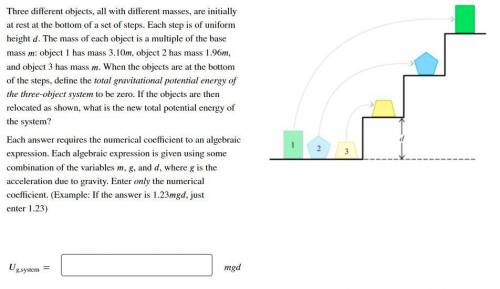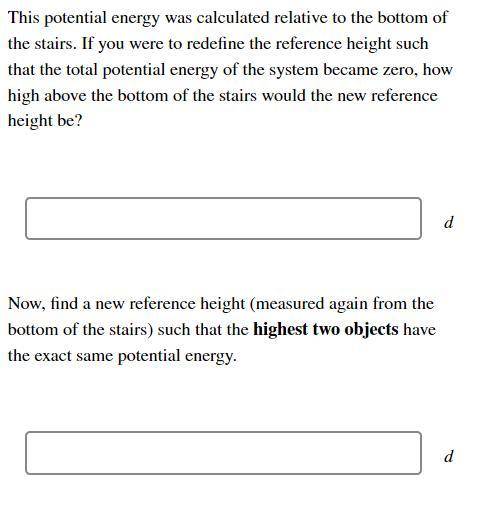
Physics, 04.02.2022 01:00 olivernolasco23
Three different objects, all with different masses, are initially at rest at the bottom of a set of steps. Each step is of uniform height . The mass of each object is a multiple of the base mass : object 1 has mass 3.10 , object 2 has mass 1.96 , and object 3 has mass . When the objects are at the bottom of the steps, define the total gravitational potential energy of the three-object system to be zero. If the objects are then relocated as shown, what is the new total potential energy of the system?
Each answer requires the numerical coefficient to an algebraic expression. Each algebraic expression is given using some combination of the variables , , and , where is the acceleration due to gravity. Enter only the numerical coefficient. (Example: If the answer is 1.23 , just enter 1.23)
This potential energy was calculated relative to the bottom of the stairs. If you were to redefine the reference height such that the total potential energy of the system became zero, how high above the bottom of the stairs would the new reference height be?
Now, find a new reference height (measured again from the bottom of the stairs) such that the highest two objects have the exact same potential energy.



Answers: 3


Other questions on the subject: Physics

Physics, 21.06.2019 16:00, mohamedramadan
Apiano tuner uses a tuner to create a tone of 5.00 x 10² hz. when a key on the piano is struck he hears 5 beats per second. what is a possible frequency of vibration for the piano string? 2500 hz 1300 hz 605 hz 495 hz
Answers: 1

Physics, 21.06.2019 23:30, jacobc7698
Jessie ran 5000 meters from the cops and an average speed of 6 meters / second before he got caught . how long did he run?
Answers: 1

You know the right answer?
Three different objects, all with different masses, are initially at rest at the bottom of a set of...
Questions in other subjects:


Physics, 15.12.2020 01:00


Mathematics, 15.12.2020 01:00

History, 15.12.2020 01:00








